We’re excited to share our brand-new reel from our Automotive team! The reel covers all of our recent work from ad campaigns, marketing films, 360 configurators and beautiful CG stills to showcase our wonderful client’s cars.
We’re excited to share our brand-new reel from our Automotive team! The reel covers all of our recent work from ad campaigns, marketing films, 360 configurators and beautiful CG stills to showcase our wonderful client’s cars.
The Lotus story continues with a new icon: Emira. We are proud to have supported Lotus Cars in creating an advanced 360-degree configurator and fully configurable CG movie; taking the Emira out of the showroom and into the real world, in the ultimate customer journey.
The configurator creates thousands of different iterations of the Emira. Choose from a range of distinctive paint colours to your choice of alloy wheels, brake callipers, black pack and interior details, all viewed within three distinctive environments which allow the colours to come to life under a range of lighting conditions. We see the car in a photographic studio, under artificial light, in the famous Lotus Design Studio in daylight and finally on the Big Sur highway in California in intense sunlight.
What colour will you choose?
Electric vehicles (EVs) are now entering the mainstream, accounting for 6.6% of new car sales last year. What’s more, their rise is only going to accelerate as rules are introduced to limit the kind of vehicles allowed into major cities.
We’re definitely seeing an increase in clients coming to us to talk about their EV launches and we’ve recently worked on fully integrated real-time 3D configurators and marketing stills for leading EVs including the Lotus Evija and the recently launched Rimac Nevera.
So, we thought it would be fun to ask our automotive team which electric vehicle they would pick if money was no object. The car-fanatics of our studio did not disappoint…Let us know which car you would choose! It’s time to get excited about making the switch to electric.
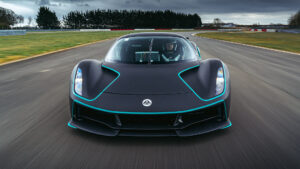
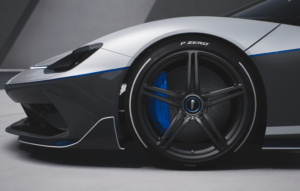
Client Services Director, Paul McSweeney, couldn’t stop at just one. “With a wife and four children I need six places. So, I choose a Lotus Evija, a Pininfarina Battista and a Rimac Nevera!” Paul is especially familiar with these particular vehicles, as our team partnered with each brand on the launch marketing campaigns and configurators for these incredible cars.
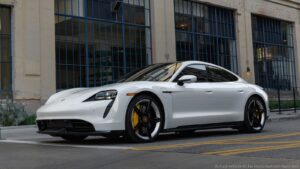
Our CEO, Tony Prosser, didn’t have to think twice before he chose the Porsche Taycan Turbo. “Instantaneous power, the biggest thrill with the safety of all-wheel drive, beautiful Porsche styling inside and out and superb German build quality. 5 stars from me.”
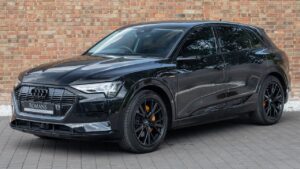
Our Senior Automotive Artist, Damian Biliński, has gone for style mixed with size and function: “My choice is the Audi e-Tron black edition. A big SUV, family friendly and just look at it, no words needed!” As well as looking the part, Audi boasts that their e-Tron is capable of travelling up to 252 miles on a single charge and can be charged in under an hour.
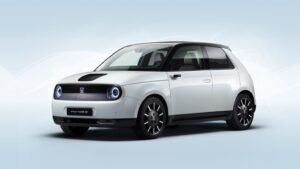
Arguably the friendliest-looking car on the list is Senior Producer, Graham James’ pick of the Honda e Electric Car – Honda’s first fully-electric urban car comes in a nifty compact size just little bit bigger than a Fiat 500: “It has an incredible retro style, with a pretty high-tech interior.”
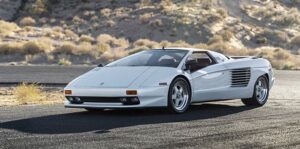
Will Wilson, Senior Automotive Artist, breaks the rules with his obscure choice, choosing to resurrect the car that very nearly made it; “There will be generations of electric cars to look forward to and enjoy. I would mark the end of an era and choose a car which to me represents the ultimate vision of what a supercar can be. The Cizeta-Moroder V16T. A car developed by Claudio Zampolli, designed by Marcello Gandini (Miura, Countach, Stratos), and powered by a Lamborghini derived V16 engine. “
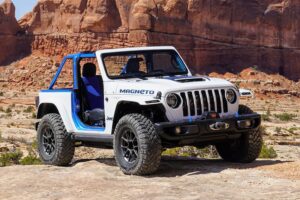
Our Operations Director, Libby Behrens, has chosen something a little more adventurous: “I love what Jeep are going to do with The Jeep Wrangler Magneto. This is because one day I will be that adventurous and go off-roading in the desert…” The Magneto’s single-motor powertrain is said to offer performance on a par with the standard Wrangler’s 3.5-litre Pentastar petrol V6, packing what they call “unmistakable rock-climbing force.” We couldn’t be more excited to see the final product.
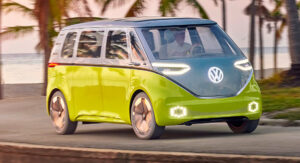
Last, but by no means least, we have Volkswagen’s ID. Buzz, curtesy of Senior UE4 Auto Artist Paul Stevenson; “A great revamp but this time without the wheezy air-cooled motor.” Unveiled at the Munich motor show, the ID. Buzz features a raft of camera, lidar and radar sensors to enable the autonomous technology developed by US start-up Argo.
What would you pick? An updated retro design or the kind of EV that looks like it’s straight out of Blade Runner? Be sure to let us know!
At REALTIME, we have 20 years of experience making car configurators for the biggest names in the automotive sector. Work with us to ensure your car configurator offers the best experience to your customers.
For more information on our car configuration options, fill out the below form or email me at [email protected]
Of all of life’s mod cons, is there one more important than the car? You could argue the television or the plane is a bigger invention, but the car might be the one that has affected the cultural zeitgeist the most. Most of the towns and cities in the world are designed around their existence after all.
As such, every corner of the world has its own approach to the world of automobiles. This means the biggest car manufacturers in the world have to adjust how they approach every country, accounting for their differences in taste while also trying to keep a consistent message.
It can seem like an impossible task; so how do car manufacturers change their approach from country to country? What factors might affect that decision? And what can they do to still keep the same brand image across the globe?
So how does car culture vary across countries? It used to be, some 15-20 years ago, that each region had its clear preferences. Over in the US, pickup trucks like the Ford F-series were far and away (and still are) the best sellers. Yet over in Europe, they had a liking for smaller diesel hatchbacks. And while prestige in the west was linked to any expensive cars, over in China, a mark of wealth was a big saloon car. And in India, they were mainly interested in models that could cope with the more challenging road surfaces and conditions.
But we live in a much different world now. In a globalised market, with social media giving us a glimpse into life around the world and emissions standards changing for the better, the differences are far less marked.
There has been a shift; pickup trucks are still best sellers in the US but are losing market share; for example, the Honda Civic and Accord were some of the most popular cars for three years in a row. With the dieselgate scandal in Europe, and the political to-and-fro around nitrous oxide emissions, sales of diesel cars have nosedived. Over in China, meanwhile, all manner of cars are doing well, with the deep-pocketed children of the old political elite buying the prestige cars they see across the world. SUVs, in particular, are faring well over there – from big-name brands too, beating out the state-owned manufacturers. And in India, the burgeoning middle classes also want their fair share of western prestige brands. Mercedes-Benz, BMW, and Audi are the top three luxury brands in the country, closely followed by Jaguar Land Rover.
So the lines between countries have blurred. While each location might have its own particular brands, there’s a greater desire for these big, global names. Not to mention the fact everyone is looking at EVs.
It isn’t insular, local culture that drives things anymore; people are aligning with a brand that represents a certain lifestyle as opposed to simply just a type of car. People trust brands. When doing their online research, 74% of consumers turn to branded video content for information. It’s something the savvier car brands are hoping to capitalise on. This presents an issue, though: how can you be a consistent ‘global’ brand?
Maintaining consistency
Somewhere this can trip car brands up is in the marketing. After all, how can manufacturers ensure dealerships around the world are representing your car in the right way? They will be operating in a very local context. If your cars are popular in different regions, you want to make sure it comes across as effectively to your US audience as it does to your European audience as it does to your Indian audience, and so on.
The important part is making sure the car itself comes across in the right way. It can be a limitation of on-location shooting for marketing materials. It might look good on the sun-drenched roads of LA, but will that speak to your audience on the other side of the world? Won’t they want to see it in a context more familiar to them?
That’s why CG imagery and sting movies are being used more and more across global brands like ŠKODA and are proving to be very effective. A CG render of your car can be inserted into any location you wish, be it the streets of Berlin or those of Bangladesh. They work particularly well as bookends to commercials and ensures your car looks the same in every shot. It means everyone across the world sees the car as you intend it to be seen.
Online solutions
It streamlines your marketing efforts; if you set out to convey one key message in your material you can rest assured it will happen in all your target markets. It’s a consistent through-line that keeps your branding on track, especially online. 95% of consumers find their information online when looking at cars, with twice as many people starting their research online versus at a dealership. So you want your online solutions for engagement, brand-building, and configuration to be global in nature.
Globalisation has changed the face of many markets and the automotive sector is no different. Companies have this delicate balancing act of assimilating to cultural differences while maintaining their global image. It’s a fine art but something that can easily be achieved by finding solutions that save you time while putting your best self forward.
At REALTIME, we are proud of the relationships we have with many leading car manufacturers who operate in markets all over the world and we have faced these challenges with them. If you would like to talk about collaborating on a future project, you can reach out to me at [email protected].
If you listen to the doom and gloom, you would think the traditional high street was dying. Look at big names like BHS and Toys R Us going under in recent years and the subsequent rise of online shopping. You can’t walk down your average high street without seeing boarded-up stores or newly emptied lots. Yet we’re still far from the collapse of the high street; online shopping only accounts for 17% of total sales, meaning the retail sector is still going strong.
So it’s hard not to look at the doom and gloom around car dealerships with the same scepticism. Articles titled ‘Why Car Dealerships Will be Extinct by 2025’ paint an ominous picture. But if the high street can survive, why can’t dealerships?
The new way of shopping
Of course, the two experiences are different. While retail has its fair share of pushy salespeople, it isn’t nearly as much of a pain point as it is for the automotive sector. According to Deloitte, less than 1% of people like the car buying experience. But they can learn a lesson from the retail sector; those that are thriving today know that they need to adapt. So it’s less ‘car dealerships will be extinct by 2025’, more ‘those who fail to change with the times will die out’.
All the information a consumer needs is at the touch of a button. Customers spend 10 hours on average researching their new car purchase, with 52% visiting the dealer’s website during the process. They are savvier and less likely to fall for sales patter. When they visit the dealership, it’s not necessarily advice they’re looking for.
So what are they looking for? Consumers crave convenience – they will want an easy time. Dealerships might not be the start of the car buying process, but they can still be a part of it. Allowing customers to choose their car at home – maybe even configuring it – before confirming their decision in-store is a good place to start. Adoption of technology like this will make customers feel less pressured, able to take it at their own pace.
They can learn a lot from the Apple store model. There, all of their expensive gadgets and toys are laid out to experiment with at your leisure. Salespeople approach you but don’t push you. SEAT has taken the idea and ran with it – they have two stores in the country that wear their convenience on their sleeve. Their website boasts their lack of ‘pushy salespeople’ and their ‘no haggle pricing’. They know what consumers want. They’ve adapted.
Take a SEAT
These SEAT stores aren’t dealerships but that doesn’t mean what they do can’t be integrated into them. They have less emphasis on the salespeople and more on their information kiosks. These are a fountain of information and adverts in the store make for a more natural pathway for consumers to experiment with the car configurators. It gives them something to ‘play’ with, opening up the door to conversions that weren’t there before.
The stores are also less about the cars, with only three on display. Counter-intuitive? Not quite; Green Room CCO Mike Roberts says it’s about ‘putting control in the hands of the customer’. If they want, they can even book a test drive nearby.
But there is pressure building from companies like Tesla, who let you buy directly, or ride-sharing apps like Uber. The next big trend might be car subscription services like Wagonex, who knows? We could see a trend of fewer, yet more robust, dealerships.
As we keep saying, the key is adoption. Make the journey from online to in-store a seamless one. Offer easily accessible options at your dealership. Understand that people want to feel in control. Give them the option to customise their car there and then, maybe even offer test drives in a VR environment.
Extinction isn’t likely to happen by 2025 but that doesn’t mean you’re invulnerable to any adverse effects. While the future looks bright for retail, companies like Debenhams still face problems. The same can be said for dealerships. The question is, what are you doing about it?
At RealtimeUK, we have extensive experience working with some of the biggest names in the automotive sector. If you need CGI solutions for your car configurator or app, get in touch with me at [email protected].